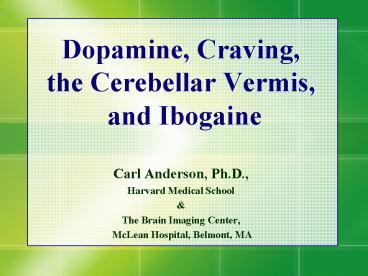Dopamine, Craving, the Cerebellar Vermis, and Ibogaine - PowerPoint PPT Presentation
1 / 19
Title:
Dopamine, Craving, the Cerebellar Vermis, and Ibogaine
Description:
The Brain Imaging Center, McLean Hospital, ... immunoreactivity (DAT-IR) in macaque cerebellar midline (anterior- and posterior ... Macaque. Summary So Far... – PowerPoint PPT presentation
Number of Views:123
Avg rating:3.0/5.0
Title: Dopamine, Craving, the Cerebellar Vermis, and Ibogaine
1
Dopamine, Craving, the Cerebellar Vermis, and
Ibogaine
- Carl Anderson, Ph.D.,
- Harvard Medical School
- The Brain Imaging Center,
- McLean Hospital, Belmont, MA
2
My Interest in Ibogaine 1993 First heard about
ibogaine from Drs. Mash and Staley. 1995
Finished my Ph.D on Ontogeny of REM
sleep. http//remfractal.mclean.org/Disseration.p
df 1998 MAPS article on Ibogaine, REM sleep
PTSD. http//www.maps.org/news-letters/v08n1/0810
5and.html 1998 Cerebellar vermis connection
with stimulants ADHD. http//remfractal.mclean
.org/ADHD_vermis.pdf 2000 Vermis, childhood
sexual abuse and drug use.
http//remfractal.mclean.org/vermis-abuse.pdf 200
3 Cerebellar Doorways to Addiction,
Hallucinogenesis, REM sleep and Trauma How the
Ibogaine Key Might Work the Vermal lock-Talk at
NYC Ibogaine meeting, May 2003.
http//remfractal.mclean.org/NYC_Ibogaine.ppt
3
Overview
- Role of the cerebellar vermis in cognitive-motor
integration - Human vermis 11CAltropane binding
- Implications in craving and reward
- Implications for thearpy
- C.C.Naranjo movement
4
Vermis Anterior
FN
Vermis Posterior
5
The Cerebellar Vermis Cognitive-Motor
Integration
- ..the fastigal nucleus plays a particularly
important role in the control of locomotion and
the merging of anticipatory and reactive CNS
processes. Mori et al. (2004) - Studies of bipedal walking in primates.
6
- Reward-Evoked Bipedal Locomotion
7
movement
- Cog-Emotion
Vermis
Fig 5 from Mori et al., 2000
8
The Vermis as a Center of Emotional-Motor
Coordination
-Balance -Eye movements -Cerebral BF -Orienting
NE, DA, 5-HT CRF, T4, NO GABA, Glu, Ach
LC, DR, SNR Vest. Nuc. PPT, NTS, RF PAG, IL,
AH ACC, BN
9
Lobule VIII enlarged in echo-locating
carnivorous mammals (M.G. Paulin, 1993 1997)
Modified version of figure 55-D (p. 45) from
Larsell and Jansen (1972)
10
From Maas et al. 1998
- Crack cocaine-dependent 6 Males4 Females 36.1
7.0 years of age and comparison subjects 3
Males5 Females 29.8 6.8 years of age.
Sections from videotape described by Childress et
al. 1996
11
Role of the Cerebellar Vermis In Cue-Induced
Cocaine Craving
From Anderson et al. in submission
12
DAT-IR in the PrimateVermis
- Melchitzky and Lewis (2000) observed dopamine
transporter immunoreactivity (DAT-IR) in macaque
cerebellar midline (anterior- and
posterior-inferior vermis, AV and PIV,
respectively), implying the possible presence of
functional DAT in homologous regions of the human
vermis.
13
Summary So Far
- The cerebellum typically is excluded from the
circuitry considered to mediate
stimulant-associated behaviors since it is low in
dopamine. - Yet, parts of the primate cerebellar vermis have
been reported to contain axonal dopamine
transporter immunoreactivity (DAT-IR), suggesting
that they may be part of the reward circuitry
14
Summary So Far
- Using fMRI, we found that cocaine-related cues
selectively activated DAT-IR-enriched lobules
II-III and VIII-IX in cocaine users. - PET imaging of healthy human subjects detected
DAT-selective ligand accumulation in the
posterior-inferior vermis (lobules VIII-IX),
suggesting the presence of DAT in this region.
15
Summary So Far
- In light of prior findings illustrating
connections between vermis and midbrain dopamine
cell body regions, established roles for the
vermis as a locus of sensorimotor integration and
motor planning, and increased vermis activation
in substance abusers during reward-related and
other cognitive tasks, we propose that the vermis
be considered one of the structures involved in
cocaine- and other incentive-related behaviors.
16
Implications for Ibogaine Therapy
- Ibogaine appears to specifically target regions
of the vermis involved in drug- and other
incentive-related behaviors. - Transient ataxia and vestibular disorders that
accompany ibogaine administration could indicate
the induction of compensation within the
vermis-fastigial system. - Movement could facilitate ibogaine-induced
compensation.
17
Claudio Naranjo on Movement During Ibogaine
Therapy
- A comfortable couch or bed must be considered
part of the setting for the treatment, for most
patients want to lie down during the first few
hours, or even throughout most of their session,
and feel nauseated when they get up or move.
However, others feel the desire to move or even
dance at some point in the session (35 per cent
in my data), and this may prove a very
significant aspect of their experience that will
be elaborated upon later. For this reason some
degree of space to move about is desirable. - From The Healing Journey, chapter 5, Pantheon
Books, New York, 1974.
18
Funding for this work was provided in part
by DA016222 (to Carl M. Anderson), DA017324
DA014674 (to Marc J. Kaufman), DA09448 DA14178
(to Perry F. Renshaw) DA15305, DA11558 (to Bertha
K. Madras) from the National Institute on Drug
Abuse (NIDA)
19
References Larsell O, Jansen J, Korneliussen H,
Mugnaini E (1972) The comparitive anatomy and
histology of the cerebellum the human
cerebellum, cerebellar connections, and
cerebellar cortex. Minneapolis The University of
Minnesota Press. Maas LC, Lukas SE, Kaufman MJ,
et al (1998) Functional magnetic resonance
imaging of human brain activation during
cue-induced cocaine craving. American Journal of
Psychiatry 155124-6. Melchitzsky DS, Lewis DA
(2000) Tyrosine Hydrolase- and Dopamine
Transporter-Immunoreactive Axons in the Primate
Cerebellum Evidence for a Lobular- and
Laminar-Specific Dopamine Innervation.
Neuropsychopharmacology 22466-72. Mori F,
Nakajima K, Tachibana A, et al (2004) Reactive
and anticipatory control of posture and bipedal
locomotion in a nonhuman primate. Prog Brain Res
143191-8. Mori S, Matsui T, Mori F, Nakajima K,
Matsuyama K (2000) Instigation and control of
treadmill locomotion in high decerebrate cats by
stimulation of the hook bundle of Russell in the
cerebellum. Canadian Journal of Physiology
Pharmacology 78945-57.

























![[PDF] READ Free Dopamine Nation: Finding Balance in the Age PowerPoint PPT Presentation](https://s3.amazonaws.com/images.powershow.com/10084555.th0.jpg?_=20240724060)

![[PDF] Scarcity Brain: Fix Your Craving Mindset and Rewire Your Habits to Thrive with Enough Ipad PowerPoint PPT Presentation](https://s3.amazonaws.com/images.powershow.com/10098818.th0.jpg?_=20240814042)



